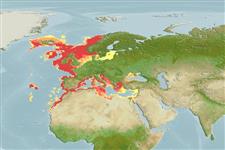>
Gadiformes (Cods) >
Phycidae (Phycid hakes)
Etymology: Phycis: Taken from Greek, phykon = seaweed; because of the habits of this fish that lives hidden among them (Ref. 45335).
Environment: milieu / climate zone / depth range / distribution range
Ecologia
marinhas bentopelágico; oceanódromo (Ref. 51243); intervalo de profundidade 10 - 1351 m (Ref. 104125), usually 100 - 450 m (Ref. 1371). Temperate; 69°N - 20°N, 29°W - 36°E
Eastern Atlantic: Norway and Iceland to Cape Blanc, West Africa; also the Mediterranean.
Comprimento de primeira maturação / Tamanho / Peso / Idade
Maturity: Lm ?, range 20 - ? cm
Max length : 110 cm TL macho/indeterminado; (Ref. 1371); peso máx. publicado: 3.5 kg (Ref. 40637); idade máx. registrada: 20 anos (Ref. 1371)
Espinhos dorsais (total) : 0; Espinhos anais: 0. Pelvic fin rays extremely elongated, reaching well beyond the origin of the anal fin. First dorsal fin with an elongate ray. Body color is brown to red-gray dorsally, becoming paler ventrally.
Depth range from 10-800 m (Ref. 1371) and from 300-1047 m in the eastern Ionian Sea (Ref. 56504). Found over sand and mud bottoms (Ref. 1371). Young more coastal and found on the continental shelf while adults migrate along the slope (Ref. 1371). Feed mainly on crustaceans and fishes (Ref. 1371). Commonly less than 45 cm TL (Ref. 1371). Marketed fresh, also as fillets and fishmeal (Ref. 1371).
Cohen, D.M., T. Inada, T. Iwamoto and N. Scialabba, 1990. FAO species catalogue. Vol. 10. Gadiform fishes of the world (Order Gadiformes). An annotated and illustrated catalogue of cods, hakes, grenadiers and other gadiform fishes known to date. FAO Fish. Synop. 125(10). Rome: FAO. 442 p. (Ref. 1371)
Status na Lista Vermelha da UICN (Ref. 130435)
Ameaça para os humanos
Harmless
Uso pelos humanos
Pescarias: espécies comerciais
Ferramentas
Relatórios especiais
Baixar XML
Fontes da internet
Estimates based on models
Preferred temperature (Ref.
123201): 5.4 - 14.6, mean 9.1 °C (based on 672 cells).
Índice de diversidade filogenética (Ref.
82804): PD
50 = 0.6255 [Uniqueness, from 0.5 = low to 2.0 = high].
Bayesian length-weight: a=0.00468 (0.00393 - 0.00557), b=3.13 (3.08 - 3.18), in cm total length, based on LWR estimates for this species (Ref.
93245).
Nível Trófico (Ref.
69278): 3.7 ±0.66 se; based on food items.
Resiliência (Ref.
120179): médio(a), tempo mínimo de duplicação da população 1,4 - 4,4 anos (K=0.21; tmax=20).
Prior r = 0.55, 95% CL = 0.36 - 0.83, Based on 2 full stock assessments.
Fishing Vulnerability (Ref.
59153): Moderate to high vulnerability (52 of 100).
Climate Vulnerability (Ref.
125649): Moderate vulnerability (38 of 100).
Nutrients (Ref.
124155): Calcium = 14.3 [7.7, 26.9] mg/100g; Iron = 0.251 [0.143, 0.429] mg/100g; Protein = 17.5 [16.2, 18.8] %; Omega3 = 0.607 [0.312, 1.129] g/100g; Selenium = 30 [15, 57] μg/100g; VitaminA = 10.7 [3.1, 36.9] μg/100g; Zinc = 0.415 [0.291, 0.603] mg/100g (wet weight);
